Scrum master. It’s one of those terms that has become commonly used in product and development circles. So much so that people assume everyone has the same understanding of what the role means.
Over time businesses have developed very different definitions of the scrum master job description. This confusion can lead to challenges. Especially when an organization tries to adopt the Scrum project management framework. You can find one real-world example of these challenges in this story published by software company Paradigma Digital:
“Oh no! I hired a scrum master and thought it was something else!”
If you’re not sure what a scrum master does, and you don’t want to ask, keep reading. We’ll review the basic role and the key responsibilities of a Scrum Master. And we’ll keep this conversation between us.
What Is a Scrum Master (and What, Exactly, Is Scrum)?
Scrum is one of several project management frameworks used by organizations that have adopted the agile development methodology.
The key concept to understand about Scrum is that it does not mandate a sequence of steps a team must follow to move a product forward. Scrum is more of a philosophy. It’s designed to help a team make progress fluidly, and adapt quickly when necessary, without being slowed by process.
Here’s where the scrum master fits in. For a product team creating software using the Scrum agile framework, the scrum master is a technical resource. Often a developer who is responsible for keeping the dev team on track. The scrum master’s main objective is to make sure the team works according to the agile values. That they have the resources, time, and disruption-free environment to succeed.
Let’s discuss what this looks like in practice by reviewing the key aspects of the scrum master’s role.
4 Key Responsibilities of a Scrum Master
1. Keep the team organized, on track, and focused on what matters.
A scrum master’s primary responsibility is to keep the development team organized and progressing on the projects they’ve agreed to, in order of priority. The Scrum Master, in other words, is there to help keep the team on track.
For example, the scrum master might lead the team’s daily standup (if the team holds them). In these brief morning meetings, the team discusses what they’ve accomplished, what they’re planning to work on that day, and any obstacles they face completing their tasks.
The scrum master will keep these meetings short and on point. Then they will act on any useful information derived from the meeting—such as finding a way to remove obstacles to the team’s progress.
The scrum master will also help to facilitate other Scrum events. Including sprint planning sessions, where the product and development teams discuss the priority items to work on in the upcoming sprint.
The scrum master’s role in these meetings will be to listen. To make sure the team has the right information. To allow participants to make decisions about projects and priorities. Their role is to capture these decisions to help the team proceed with the agreed-upon plan.
2. Serve as a bridge between product management and development.
One ongoing risk in creating any product is that the product management team does not clearly communicate its strategic vision to the developers who will be building the product. If the big-picture product strategy becomes lost in translation, the developers might focus on the wrong priorities or make decisions—to save time, for example—that undermine the product vision.
In an agile organization, the scrum master can mitigate these risks. They act as a communication bridge between product management and development.
In a company that has a product owner, the scrum master will interact with the person in that role. For example, the scrum master might share with the product owner the dev team’s request to break a task into smaller pieces before adding it to a sprint, along with their reasoning. The product owner will then convey this information to the product manager.
When the product management team has requests for the development team or wants to communicate its strategic thinking to them, the product owner (or product manager) will share the information with the scrum master to pass along to their team.
One of the keys to being an effective scrum master is maintaining a strong working relationship with the product owner and the product management team. Thus helping to ensure that product management and development are regularly sharing information. That the two teams are operating from a position of mutual trust and respect.
3. Clear obstacles and protect the team from distractions.
When the developers discover a dependency or other challenge preventing them from completing a sprint task, it will be up to the scrum master to clear that obstacle so the team can continue its work.
When a product manager goes directly to the dev team with an urgent last-minute request—for example, to create custom code for a large customer—it will be the scrum master’s responsibility to remind the PM that the team can work only on the tasks agreed to in the current sprint.
Interruptions and challenges like these will often appear during the product development process. An effective scrum master will always be there to protect their developers’ time and to create an environment where they have a clear path to focus on doing their best work.
4. Lead through influence and credibility.
As the Agile Alliance explains, a Scrum Master has a lot of responsibility but no real authority in the company hierarchy. (Product managers: Sound familiar?) This is one reason some companies describe their scrum master as a team coach or agile coach. These professionals lead their team, but they must do so from the earned position of a trusted expert and guide—not as a manager or supervisor who can dictate orders.
To succeed in this role, a Scrum Master needs to build credibility with the team. This won’t happen immediately but will have to be earned over time. Here are some of the strategies you can use as a Scrum Master to earn this trust.
5 Ways to Earn Trust as a Scrum Master
1. Act as a champion for your team’s success.
You can do this by protecting them against distractions. By communicating their needs and concerns to product management and other stakeholders, or helping to clear roadblocks to the team’s progress.
2. Coach your team to work more effectively within the Scrum framework.
Often a cross-functional team implements Scrum without knowing how to make the most of the framework. Your expertise and hands-on guidance can make your team feel more comfortable with this new approach. It can help bolster your credibility with them.
3. Stay accessible to your team for questions and requests.
As a Scrum Master, one of the simplest ways to earn your team’s trust is to be there for them when they need you. This means promptly responding when they request your help, listening carefully to their concerns, and acting quickly to resolve their issues.
4. Communicate often with your team.
You can do this via daily standup meetings, for example. Frequent communication with your team can help you catch potential problems early and demonstrate your ongoing commitment to ensuring the team has what it needs to succeed.
5. Be willing to take the blame.
As scrum master, you are the facilitator of your team’s work. That means if the team runs out of time during a sprint before they’re able to complete one of the items, some of the blame rests with you. Taking responsibility within your company for these setbacks, and protecting your team, will help you quickly establish the trust and respect you’ll need to become a highly effective scrum master.
Learn More About Agile Success with Our Book:






